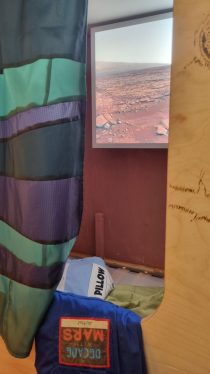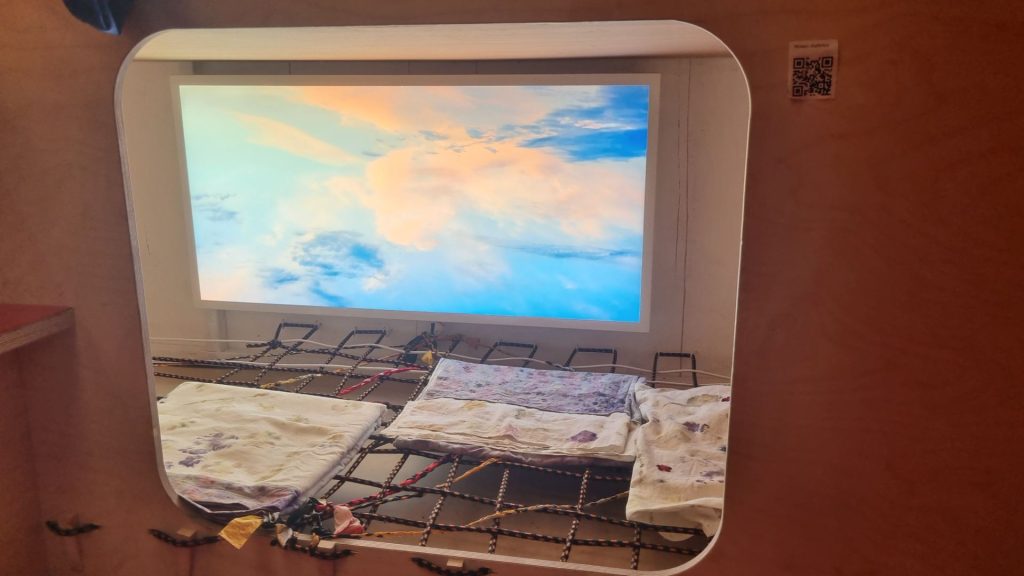A View of Mars: HydroPoetics at the Martian House
By Benjamin Park, University of Bristol PhD student

As she pulled back the blue and green curtain that closed off a small sleeping pod built into the wall, with just enough room for some comfortable pillows and light bedding, we looked up to a screen – which served to represent a window onto a Martian landscape – with an image of red rock and a barren land laden with dust. Katy spoke about the experience of someone living in a Martian home. She spoke about the dust storms, the implacable cold, the constant threat of radiation, all contained in that image of barren stone. It was at that point I realised the importance of a small garden space to people 109.22 million kilometres from Earth.
 On the banks of the harbour at Museum Square there is an unusual building. Seen from a distance one can make out a bright red structure topped with a shining silver dome. This is the Martian House. The exterior is captivating, and upon closer look it is beautifully decorated with murals, posters, and information detailing the Martian House project, its origins, its outcomes, and the questions it inspires about our future. However, the true wonders of the Martian House are found within its airtight walls.
On the banks of the harbour at Museum Square there is an unusual building. Seen from a distance one can make out a bright red structure topped with a shining silver dome. This is the Martian House. The exterior is captivating, and upon closer look it is beautifully decorated with murals, posters, and information detailing the Martian House project, its origins, its outcomes, and the questions it inspires about our future. However, the true wonders of the Martian House are found within its airtight walls.
I was part of a small group of hydroponic enthusiasts and inquisitors into the future of human ecology who arrived at the Martian House to take part in artist Katy Connor’s HydroPoetics workshop. The building is composed of two repurposed shipping containers and a large dome. On Mars the domes would be constructed out of a combination of Martian soil and concrete slurry. The houses would be placed on top of natural craters to increase living space, and each house would be connected to a central community space thus forming an interconnected Martian hamlet. As we walked around the Martian House the walls were adorned with designed objects that you may want or need on Mars. The items were made from reused materials, all low-tech and easy to construct. A hammock made from parachute, an amp made from a coffee tin, and a guitar made with the fewest parts possible. One could imagine a Martian citizen, reclining in the hammock and strumming a few gentle chords.
 These items were imagined and decided upon through the project’s interaction with the community, an essential aspect of its research practice. The story of the Building a Martian House and HydroPoetics begins with Ella Good and Nicki Kent, freelance artists with a participatory, socially led practice. They formed an artistic project entitled A Decade with Mars which is focused on understanding Earth through understanding Mars, and exploring visions of the future. In the fourth year of this project, the Brigstow Institute funded an ideas exchange entitled Life on Mars? Building a Martian House. This ideas exchange brought the artists together with Dr Lucy Berthoud an expert on Spacecraft Systems Engineering and Hugh Broughton an architect who designed the Halley VI British Antarctic Research Station. This led to the design and eventual construction of the unusual and extraordinary building we had found ourselves in. In 2022 this project further developed with Growing Liveable Worlds: Ethical Encounters Between Human and Plant Life a Brigstow funded experimental partnership inspired by Natasha Myers’ work on the Planthroposcene. This experimental partnership introduced artist Katy Connor into the project alongside cultural geographer Franklin Ginn, and biological scientists Jane Memmott and Bethany Eldridge to consider the speculative scenario of terraforming Mars through a hydroponic technogarden. With HydroPoetics the art project reflected on questions of science, technology, botany, materiality, and ethics. Throughout all its developments and iterations, the artistic and research projects that surround the Martian House and HydroPoetics have been driven by interdisciplinary research and practice, creative public engagement and community driven feedback. This ongoing and malleable art/research project has constantly questioned the relationship between humans and their environment, exposing what we take for granted and envisioning the potential paths this relationship may travel in the future.
These items were imagined and decided upon through the project’s interaction with the community, an essential aspect of its research practice. The story of the Building a Martian House and HydroPoetics begins with Ella Good and Nicki Kent, freelance artists with a participatory, socially led practice. They formed an artistic project entitled A Decade with Mars which is focused on understanding Earth through understanding Mars, and exploring visions of the future. In the fourth year of this project, the Brigstow Institute funded an ideas exchange entitled Life on Mars? Building a Martian House. This ideas exchange brought the artists together with Dr Lucy Berthoud an expert on Spacecraft Systems Engineering and Hugh Broughton an architect who designed the Halley VI British Antarctic Research Station. This led to the design and eventual construction of the unusual and extraordinary building we had found ourselves in. In 2022 this project further developed with Growing Liveable Worlds: Ethical Encounters Between Human and Plant Life a Brigstow funded experimental partnership inspired by Natasha Myers’ work on the Planthroposcene. This experimental partnership introduced artist Katy Connor into the project alongside cultural geographer Franklin Ginn, and biological scientists Jane Memmott and Bethany Eldridge to consider the speculative scenario of terraforming Mars through a hydroponic technogarden. With HydroPoetics the art project reflected on questions of science, technology, botany, materiality, and ethics. Throughout all its developments and iterations, the artistic and research projects that surround the Martian House and HydroPoetics have been driven by interdisciplinary research and practice, creative public engagement and community driven feedback. This ongoing and malleable art/research project has constantly questioned the relationship between humans and their environment, exposing what we take for granted and envisioning the potential paths this relationship may travel in the future.
Returning to our small group in the Martian House… After we examined these minimal-design-house-items, Katy led us up a narrow set of metal stairs into the dome. We first entered the ‘dining area’, where we placed on lab coats to protect the hydroponic plants from potential pathogens. A tea set sat on a small table in the corner, containing a dark liquid steeped from the leaves of lemon  verbena that had been grown in the adjacent room. As we passed through into the hydroponic room, Katy began to explain the set up and process of hydroponic gardening, explaining both her experience and the envisaged experience of future Martian humans. From these conversations the wealth of the research project was evident. We discussed the potential of hydroponics as a response to climate issues and resource scarcity; the benefits to mental wellbeing offered by the practice of plant growing and the presence of greenery (first noted on in an astro-context in the 1970s by Soviet cosmonauts during their experiments with germination in microgravity); the human-engineered lifecycle of resources, the important question of where they came from and where they will go when ‘used’; the problems of hydroponic pollination in Mars due to the absence of bees and Katy’s collaboration with Bristol Robotics to trial tiny swarm robotics or a pollinating robotic arm; the issue of sourcing alternative substrate to toxic rockwall or plastic sponges in which to grow the plants; the problems of planned obsolescence in current hydroponic systems and the ecological cost of international shipping and manufacture; the use of bioluminescent algae as a handheld lamp on Mars; the lack of a ‘dormant period’ for plants in modern industrial farming, akin to a lack of sleep for humans; and the human experience of confronting the vast emptiness of space, in all its wonder and terror, and the comfort that a small part of Earth, found in the growing of hydroponic plants, would bring to those future extra-terrestrial humans.
verbena that had been grown in the adjacent room. As we passed through into the hydroponic room, Katy began to explain the set up and process of hydroponic gardening, explaining both her experience and the envisaged experience of future Martian humans. From these conversations the wealth of the research project was evident. We discussed the potential of hydroponics as a response to climate issues and resource scarcity; the benefits to mental wellbeing offered by the practice of plant growing and the presence of greenery (first noted on in an astro-context in the 1970s by Soviet cosmonauts during their experiments with germination in microgravity); the human-engineered lifecycle of resources, the important question of where they came from and where they will go when ‘used’; the problems of hydroponic pollination in Mars due to the absence of bees and Katy’s collaboration with Bristol Robotics to trial tiny swarm robotics or a pollinating robotic arm; the issue of sourcing alternative substrate to toxic rockwall or plastic sponges in which to grow the plants; the problems of planned obsolescence in current hydroponic systems and the ecological cost of international shipping and manufacture; the use of bioluminescent algae as a handheld lamp on Mars; the lack of a ‘dormant period’ for plants in modern industrial farming, akin to a lack of sleep for humans; and the human experience of confronting the vast emptiness of space, in all its wonder and terror, and the comfort that a small part of Earth, found in the growing of hydroponic plants, would bring to those future extra-terrestrial humans.
In these discussions the poetry of hydroponics came out. The hydroponic plants seemed to serve as living sculptures signifying the complex relationship between humans and plants and the silent poetry contained in our bond.
Katy explained to us that as an homage to the long history of humankind’s relationship with plants and their manipulation of the planthroposcene, she had been planting the seeds in accordance with the lunar cycle, an ancient agricultural practice. This introduced an interesting question, as the same would not be possible on Mars, which has no moon. This led us to wonder what forms of modern agricultural rituals would develop within the first colony of humans to Mars. The Earth and Moon are visible with the naked eye from Mars. From Mars an observer would be able to watch a unique form of lunar cycle, one in which the Earth and Moon fluctuate between appearing as a single point of light and appearing as two distinguishable objects, which occurs as the orbit of the Moon carries it from one side of the earth to the other. Perhaps this would form the basis of their own lunar agricultural ritual and provide them with another link to their home planet.





